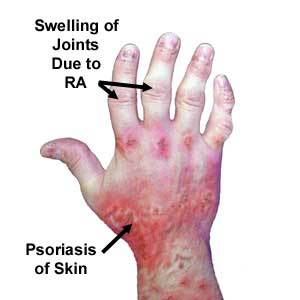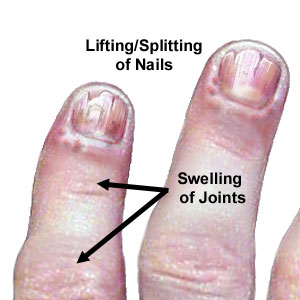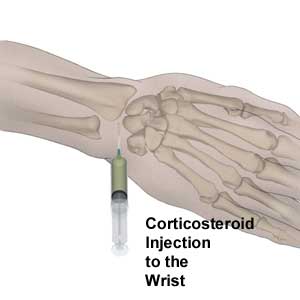|
Psoriatic
Arthritis
Written by DynoMed.com, Indianapolis,
IN
Psoriatic arthritis is related
to the skin condition psoriasis. It causes pain and swelling in some joints
and scaly skin patches on a number of places on the body. About 10 to
30 percent of people who have psoriasis will develop this type of arthritis.
Psoriatic arthritis can occur at any age in men and women, but it is more
common in people between the ages of 20 and 50.
Psoriasis is a rough, scaly
patch type of rash that affects about 30 million Americans. The rash commonly
appears on the scalp, elbows and knees. People may also experience problems
with their toes, fingernails and/or eyes. In about 15 percent of psoriatic
arthritis cases, the arthritis part of the disease appears first. Psoriasis
is not contagious and its cause is unknown. Some experts believe that
having a weakened immune system will put people at risk of developing
psoriasis. Cuts and scrapes and insect bites are known triggers for causing
a flare-up.

Causes of Psoriatic
Arthritis
The causes of psoriasis and psoriatic arthritis are unknown. Some doctors
believe it may be partly inherited and environment might play a role.
In order to find out if you are suffering from psoriatic arthritis, your
doctor may order X-rays, blood tests and joint fluid tests. He or she
will ask you for your medical history and will examine your body.
Symptoms of Psoriatic
Arthritis
The symptoms usually come on slowly and the majority of people with psoriatic
arthritis have a mild case. More than 80 percent of people with psoriatic
arthritis will have problems with their fingernails and/or toenails. Joints
that are usually affected include the wrist, knee, ankle, lower back and
neck.
Symptoms of psoriatic arthritis
include:
- Silver or grey scaly spots
on the scalp, elbows, knees and/or lower end of the spine
- Lifting or pitting of fingernails/toenails
- Redness and pain in the
eye
-
Pain, stiffness and swelling in one or more joints and the soft tissue
surrounding them
-
Swelling of fingers and/or toes
- Limited range of motion

Five Types of Psoriatic
Arthritis
There are five types of psoriatic arthritis. A person may have one or
more types. Each type has its own progression and course of treatment.
- Asymmetric arthritis:
Asymmetric arthritis does not occur in the same joints on both sides
of the body and usually affects only one to three joints. Typically
the knee, hip, ankle or wrist will be affected. You may notice that
your hands and feet are swollen and the joints may be warm, tender or
red. This form is generally mild and is the most common.
- Symmetric arthritis:
This type is similar to rheumatoid arthritis but is typically milder
and with less cases of deformity. It can be severe and multiple joints
on both sides of the body may be affected. For instance, if one knee
is affected, the other will be too. The accompanying psoriasis may be
particularly bad in this type of psoriatic arthritis.
- Distal Interphalangeal
Predominant:
Sometimes mistaken for osteoarthritis, this type usually affects the
last joint of the fingers and toes (distal interphalangeal joint).
- Spondylitis or Psoriatic
Spondyloarthritis:
A rare but serious condition, spondylitis can cause deformity and changes
in posture. Inflammation of the spine is the most common symptom. Movement
may be painful as the neck and lower back may also be stiff and inflamed.
- Arthritis Mutilans:
Less than five percent of people with psoriatic arthritis have this
serious type of arthritis. Usually the small joints in the hands and
feet are affected. This type is unusually severe because it may actually
destroy the bones and cartilage. Pain may be associated to skin flare-ups
and remissions.
Treatment of Psoriatic
Arthritis
At this time, there is no cure for psoriatic arthritis. Every patient
is different, and your treatment program will be tailored to fit your
own particular needs. Your doctor may advise you to see a dermatologist,
a doctor who specializes in skin diseases, for treatment of your psoriasis.
Depending on your case, a rheumatologist may be called in for specialized
treatment.

Soaking in warm water or using
heat or cold applications may provide some pain relief. Make sure you
get enough rest and proper nutrition. Your doctor may also suggest an
exercise program to improve the health of your joints. Your doctor can
work with you to find the best treatment for your type of psoriatic arthritis.
|

